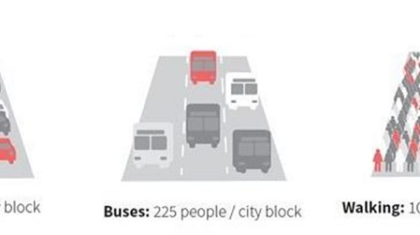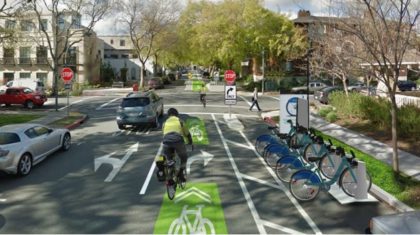By Phil Goff, LEED AP, Senior Associate, Alta Planning + Design
For many of us in the transportation planning and engineering field, nothing beats seeing a project implemented, especially benefiting your friends and neighbors. For me that project is the recent reconstruction of Massachusetts Avenue (Mass Ave.) through East Arlington, where I live.
For decades, over 17,000 cars per day sped through East Arlington along a wide road that originally carried a busy streetcar line. The removal of the tracks and center-median platforms in the late 1960’s left a 67’-78’ wide roadway with few traffic controls and no designated lanes. The result was a free-for-all of merging and swerving vehicles, bicyclists relegated to the door zone of parked cars, and pedestrians forced to play Russian Roulette crossing the street.

When I moved to the neighborhood in 2006, I was not surprised to learn that two elderly pedestrians were struck by cars and killed while crossing Mass Ave in separate incidents ten years earlier. However, our Congressman had since appropriated $5 million for a redesign. When the planning process began in late 2008, I founded East Arlington Livable Streets (EALS) Coalition to promote Complete Streets principles for Mass Ave and was appointed as one of two neighborhood representatives on the Town’s Design Review Committee.
Within months, the engineering consultants recommended a “road diet” for the de facto four-lane roadway: one lane in each direction, with turn pockets and bike lanes. It did not take long for a group of local residents and businesses to come out strongly against the plan. At the 2nd community meeting in spring 2009, most of the 400 people in attendance were opposed to the proposed road diet.

To the opponents, space was being taken away from cars for the benefit of the “small handful” of bicyclists (i.e. any number less than the number of cars) using Mass Ave. The group spent $80,000-$100,000 to hire a traffic consultant, environmental engineer, an attorney and a public relations firm to perpetuate misperceptions about the design. They falsely argued that the resulting traffic congestion would block emergency vehicles, long queues would create unacceptable levels of pollution, parking removal would cripple local businesses, and frustrated commuters would cut through neighborhood side streets.
I felt part of the problem was the project team’s inability to clearly explain traffic analysis, safety benefit for all modes of transportation, and aesthetic improvements to the business district. We worked to create support by emphasizing:
- Pedestrian safety benefits
- Normalization of the currently chaotic traffic flow
- Improved sense-of-place the new design would bring to the one-mile long corridor
I developed a series of before/after renderings and used them for the EALS Coalition web site and fliers. I then went door-to-door to dozens of businesses and used the fliers as a discussion item. Although project opponents claimed that over 75% of the business owners signed a petition against the current plan, I found a far more-nuanced set of opinions. Many were simply concerned about the impacts of construction, but were cautiously optimistic that the new design would slow traffic and create a more shopping-friendly environment.



Conversations with business owners, along with other community members organizing via e-mail and Facebook, began to pay dividends as the public process entered its third and fourth years. At each succeeding public meeting, a greater percentage of the hundreds of attendees supported the road diet plan. People injured on Mass Ave. came to testify in support. Business owners and parents of school-age children testified in support. At the final public meeting — MassDOT’s 75% design hearing — more than ¾ of the nearly 60 people who spoke expressed strong support for the plan. This provided the back-up needed by the Town’s Board of Selectmen, our State delegation and MassDOT to fully support the plan and receive all of the necessary approvals. Sadly, during this final phase — just before and just after construction began in the Fall 2014 — there were two more pedestrian fatalities. Like the two in 1996, both were elderly people simply trying to walk across Mass Ave. in an unsignalized crosswalk.
Mass Ave. in now complete. MassDOT, elected officials, and I cut the ribbon in this past November. As expected, traffic flows more predictably and slowly than before. At the moment, driving the corridor likely takes an extra 30 seconds during peak hour. Bicyclists have arguably the most generous bike lanes in all of Greater Boston. Though not perfect by any stretch, crossing Mass Ave. on the improved/new crosswalks is far less nerve-racking than before. I am proud of my efforts to organize the community and help build a Complete Street “case study” for other towns and cities throughout Massachusetts to emulate. Mass Ave. in East Arlington will likely remain as one of my most-significant contributions to creating more walkable and bikable communities.



